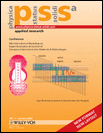Engineering of an insulating buffer and use of AlN interlayers: two optimisations for AlGaN–GaN HEMT-like structures
Abstract
The semi-insulating character of GaN epitaxial layers can be achieved by the control of the early stages of growth on the substrate. Adding two low temperature (LT) AlN interlayers is a technique enough powerful to reduce threading dislocation densities by up to one order of magnitude. A compressive strain as high as 2.8 × 10–3 is induced in the uppermost GaN epilayer. The global structure is kept semi-insulating so that it is a perfect template for undoped AlGaN–GaN HEMTs (High Electron Mobility Transistors). HEMTs with interlayers present better two dimensional electron gas (2DEG) properties: up to 20% higher carrier density (nS) and 40% higher mobility. Typically nS is as high as 1.7 × 1013 cm–2 for a record mobility of 1200 cm2/Vs. The improvement of the mobility can be correlated to the reduction of nano-scale V-shaped defects in the AlGaN (less morphological-relaxation). The improvement of nS could be explained by the higher piezo-doping resulting from GaN extra-compression and AlGaN weaker relaxation. As a consequence, the DC transistors characteristics are improved: in 2 μm gate transistors, the maximum current and transconductance are increased by up to 80% and 20%, respectively, and could be extrapolated to values as high as 1500 mA/mm and 250 mS/mm for 0.2 μm gate devices.




